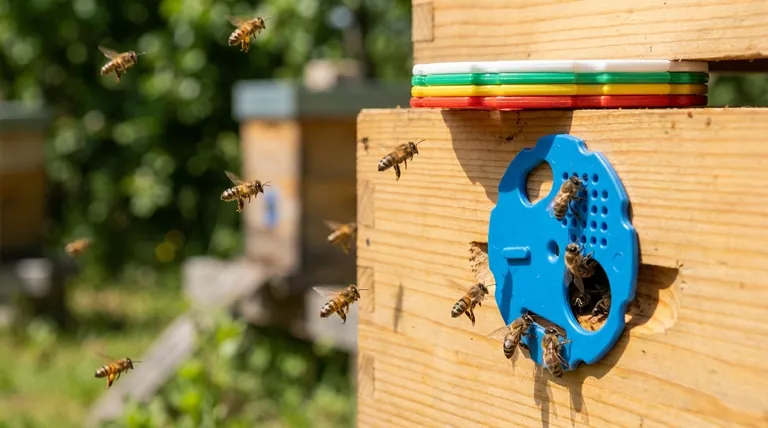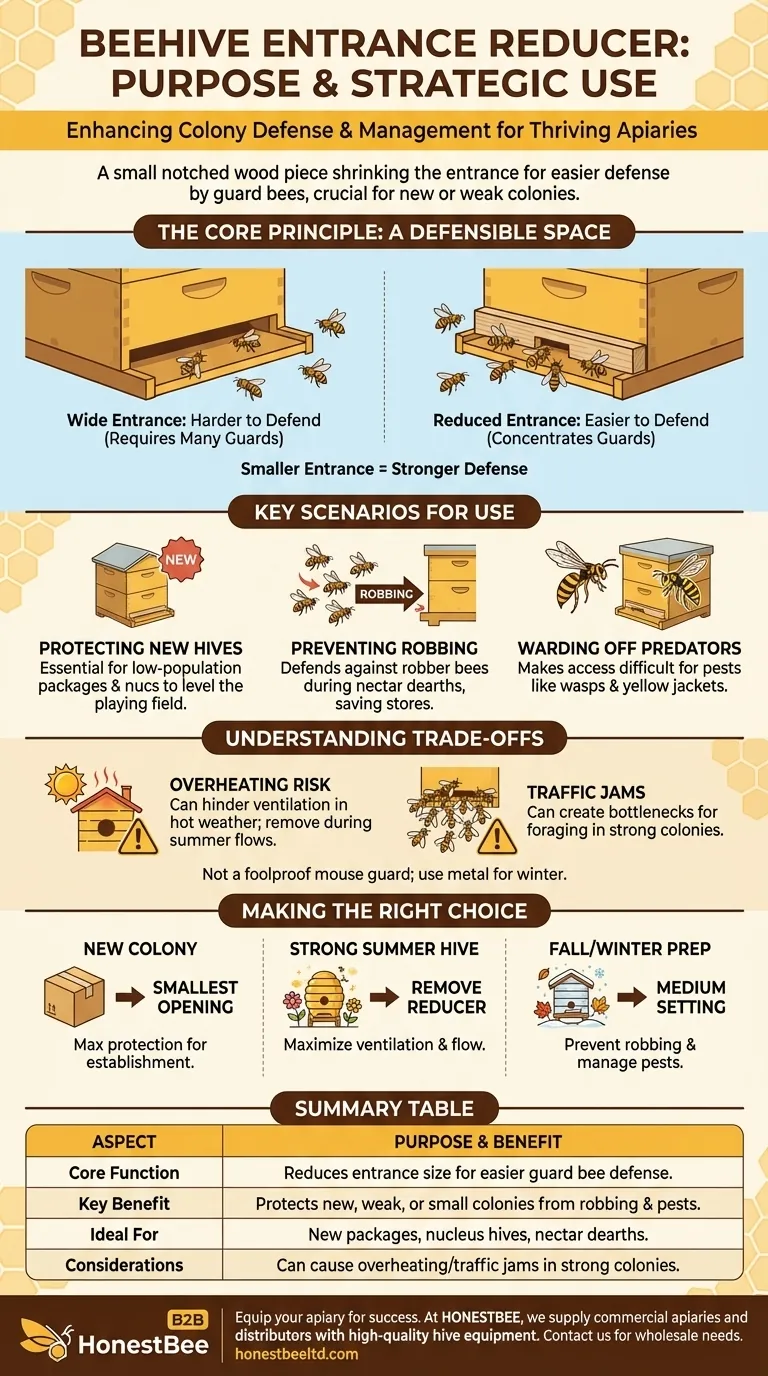In short, a beehive entrance reducer is a small, notched piece of wood placed at the entrance of a beehive to shrink its size. Its primary purpose is to make the hive more defensible for the colony. By creating a smaller doorway, the guard bees can more effectively control access and protect their home from threats.
The central takeaway is that a smaller entrance is an easier entrance to defend. The entrance reducer is a simple but critical tool that empowers a honey bee colony, especially a young or weak one, to protect its resources and survive.

The Core Principle: A Defensible Space
A honey bee colony is a fortress, and like any fortress, its entrance is a point of vulnerability. The size of that entrance directly impacts the colony's ability to mount an effective defense.
How a Small Entrance Helps Guard Bees
A wide-open entrance requires a large number of guard bees to patrol it effectively. By reducing the size of the opening, the colony can concentrate its defensive forces. A smaller chokepoint is far easier for a few guards to monitor and repel intruders.
Reducing the Burden on the Colony
For a new or struggling colony, every bee has a critical job. By making the hive entrance more manageable, the entrance reducer frees up bees that would otherwise be needed for guard duty to perform other vital tasks, such as foraging or caring for the brood.
Key Scenarios for Using an Entrance Reducer
While not always necessary for a powerful, established colony, the reducer is indispensable in several specific situations.
Protecting New or Weak Hives
A newly installed package of bees or a small nucleus hive has a low population. These small colonies are prime targets for stronger, neighboring hives. The reducer gives them a fighting chance by leveling the playing field at the front door.
Preventing Robbing from Other Bees
During a nectar dearth (a period when few flowers are blooming), honey bees from other colonies may try to steal the honey stores from weaker hives. This "robbing" behavior can decimate a colony. An entrance reducer is the first and most important line of defense against it.
Warding Off Predators and Pests
The reducer also helps keep out other unwanted visitors. Pests like yellow jackets and wasps find it much harder to slip past vigilant guards at a small opening.
Understanding the Trade-offs
Using an entrance reducer is a strategic decision, not a permanent one. It comes with important considerations and limitations.
The Risk of Overheating
The hive entrance is also crucial for ventilation. In hot weather, a restricted entrance can hinder airflow, potentially causing the hive to overheat. During strong summer nectar flows, reducers are often removed entirely.
Potential Traffic Jams
For a strong, booming colony, a small entrance can create a bottleneck. Foraging bees returning with nectar and pollen can get backed up, reducing the colony's overall efficiency.
The "Mouse Guard" Limitation
While a reducer can deter mice from entering the hive in the winter, it's not foolproof. A determined mouse can chew through a wooden reducer. For reliable winter protection, a dedicated metal mouse guard is the superior choice.
Making the Right Choice for Your Colony
Your decision to use a reducer should be based on the colony's current strength and the time of year.
- If you are installing a new package or nucleus hive: Always use the smallest opening on the reducer to give the new colony maximum protection as it establishes itself.
- If you have a strong, populous hive in peak summer: Remove the reducer entirely to maximize ventilation and prevent traffic jams during the main nectar flow.
- If you are preparing your hive for fall and winter: Reinstall the reducer (often to a medium setting) to prevent robbing and help the colony manage its entrance against pests like mice.
Ultimately, the entrance reducer is a simple tool that allows you to dynamically manage your colony's security based on its needs.
Summary Table:
| Aspect | Purpose & Benefit |
|---|---|
| Core Function | Reduces the hive entrance size to make it easier for guard bees to defend. |
| Key Benefit | Protects new, weak, or small colonies from robbing by other bees and pests. |
| Ideal For | New packages, nucleus hives, and periods of nectar dearth. |
| Considerations | Can cause overheating in summer and traffic jams for strong colonies. |
Equip your apiary with the right tools for success. A beehive entrance reducer is just one piece of essential equipment for a thriving operation. At HONESTBEE, we supply commercial apiaries and beekeeping equipment distributors with the high-quality, durable supplies needed to protect and manage colonies effectively. From entrance reducers to full hive systems, our wholesale-focused operations ensure you get the reliable equipment your business depends on.
Contact our team today to discuss your wholesale needs and strengthen your hive management strategy.
Visual Guide

Related Products
- Multi-Functional Rotary Hive Entrance Disc for Beekeeping
- Multi-Functional Sliding Hive Entrance for Beekeeping
- Professional Drop-Style Hive Handles for Beekeeping
- HONESTBEE Entrance Bee Feeder Professional Hive Nutrition Solution for Beekeeping
- Professional Hive Front Entrance Bee Feeder
People Also Ask
- How does the outer cover create an upper entrance? Master Hive Ventilation & Congestion Control
- What is the purpose of the steel entrance disc? Master Hive Traffic Control & Security
- What are the applications of the steel entrance disc? A Beekeeper's Guide to Hive Control
- What does a fully closed setting on a round beehive entrance disc indicate? A Guide to Hive Security
- How does entrance configuration vary seasonally for beekeepers? A Guide to Year-Round Hive Health



















